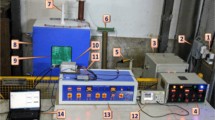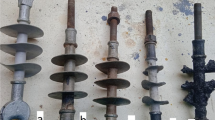Abstract
Polymeric outdoor insulators are increasingly employed in transmission and distribution systems. The various electric and environmental stresses significantly affect their long-term performance due to their organic nature, leading to degradation and aging of the insulation materials. Experimental studies have been carried out on in-service polymeric outdoor insulators for more than 20 years (400 kV and 132 kV) to investigate the structural changes and the effects of these stresses on the degradation and aging of the housing material (silicone rubber). The silicone rubber was subjected to the following tests: Fourier transform infrared spectroscopy, scanning electron microscopy and energy-dispersive X-ray, and hydrophobicity measurements. In addition, the equivalent salt deposit density and non-soluble deposit density measurements and tensile strength measurements have been carried out. The results of the field-aged polymeric insulators are compared with fresh samples also. These investigations show some interesting results, which are presented and analyzed. Finally, a 2D axisymmetric model of the 132-kV insulator was developed using COMSOL Multiphysics and the finite element method. One mitigation technique for excessive electric stress was studied using field grading composite (FGM) based on zinc oxide microvaristors. Suitable electrical characteristics and an optimized design of field grading material have been proposed to effectively control the electric stress of the 132-kV polymeric outdoor insulators under various operating conditions. The results of the simulation demonstrate that using FGMs can significantly improve the performance of polymeric insulators in the field. Further development of FGM and experimental investigations are planned.


















Similar content being viewed by others

Data availability
This declaration is “not applicable.”
References
Hackam R (1999) Outdoor HV composite polymeric insulators. IEEE Trans Dielectr Electr Insul 6(5):557–585. https://doi.org/10.1109/TDEI.1999.9286745
Verma AR, Reddy BS (2019) Interpretation of surface degradation on polymeric insulators. Eng Fail Anal 95:214–225. https://doi.org/10.1016/j.engfailanal.2018.09.007
Meyer LH, Cherney EA, Jayaram SH (2004) The role of inorganic fillers in silicone rubber for outdoor insulation alumina tri-hydrate or silica. IEEE Electr Insul Mag 20(4):13–21. https://doi.org/10.1109/MEI.2004.1318835
Papailiou K, Schmuck F (2013) Silicone composite insulators. Springer, Berlin, Heidelberg. https://doi.org/10.1007/978-3-642-15320-4
Goudie JL, Owen MJ, Orbeck T (1998) A review of possible degradation mechanisms of silicone elastomers in high voltage insulation applications. In: 1998 Annual report conference on electrical insulation and dielectric phenomena (Cat. No. 98CH36257) (Vol. 1, pp. 120–127). IEEE. https://doi.org/10.1109/CEIDP.1998.733878
Khan Y (2009) Impact of arid desert’s simulated environmental conditions on high voltage polymeric insulators. Am J Eng Appl Sci 2(2):438–445
Venkatesulu B, Thomas MJ (2011) Long-term accelerated weathering of outdoor silicone rubber insulators. IEEE Trans Dielectr Electr Insul 18(2):418–424. https://doi.org/10.1109/TDEI.2011.5739445
Phillips AJ, Maxwell AJ, Engelbrecht CS, Gutman I (2014) Electric-field limits for the design of grading rings for composite line insulators. IEEE Trans Power Deliv 30(3):1110–1118. https://doi.org/10.1109/TPWRD.2014.2362074
Nandi S, Subba BR, Sharma D (2020) Understanding performance of transmission and distribution insulators at very low temperature conditions. Electr Eng 102(4):2255–2268. https://doi.org/10.1007/s00202-020-01019-1
Tousi MM, Ghassemi M (2020) Combined geometrical techniques and applying nonlinear field dependent conductivity layers to address the high electric field stress issue in high voltage high-density wide bandgap power modules. IEEE Trans Dielectr Electr Insul 27(1):305–313. https://doi.org/10.1109/TDEI.2019.008493
Roberts A (1995) Stress grading for high voltage motor and generator coils. IEEE Electr Insul Mag 11(4):26–31. https://doi.org/10.1109/57.400761
Christen T, Donzel L, Greuter F (2010) Nonlinear resistive electric field grading part 1: theory and simulation. IEEE Electr Insul Mag 26(6):47–59. https://doi.org/10.1109/MEI.2010.5599979
Abd-Rahman R, Haddad A, Harid N, Griffiths H (2012) Stress control on polymeric outdoor insulators using Zinc oxide microvaristor composites. IEEE Trans Dielectr Electr Insul 19(2):705–713. https://doi.org/10.1109/TDEI.2012.6180266
Yang X, Zhao X, Hu J, He J (2018) Grading electric field in high voltage insulation using composite materials. IEEE Electr Insul Mag 34(1):15–25. https://doi.org/10.1109/MEI.2018.8246118
Zhao X, Yang X, Hu J, Wang H, Yang H, Li Q, Li X (2019) Grading of electric field distribution of AC polymeric outdoor insulators using field grading material. IEEE Trans Dielectr Electr Insul 26(4):1253–1260. https://doi.org/10.1109/TDEI.2019.007989
Halloum M R, Sahoo A K, Razouk Y (2021) Control of polymeric outdoor insulators stress by using nonlinear field grading materials. In: 2021 7th international conference on electrical energy systems (ICEES) (pp. 659–664). IEEE. https://doi.org/10.1109/ICEES51510.2021.9383676
Halloum M R, Reddy B S, Razouk Y (2021) Optimization of electric field distribution for 33kV polymeric insulator using non-linear field grading composites. In: 2021 IEEE 5th international conference on condition assessment techniques in electrical systems (CATCON) (pp. 292–297). IEEE. https://doi.org/10.1109/CATCON52335.2021.9670475
Donzel L, Greuter F, Christen T (2011) Nonlinear resistive electric field grading part 2: Materials and applications. IEEE Electr Insul Mag 27(2):18–29. https://doi.org/10.1109/MEI.2011.5739419
Pradhan M, Greijer H, Eriksson G, Unge M (2016) Functional behaviors of electric field grading composite materials. IEEE Trans Dielectr Electr Insul 23(2):768–778. https://doi.org/10.1109/TDEI.2015.005288
Yang X, He J, Hu J (2015) Tailoring the nonlinear conducting behavior of silicone composites by ZnO microvaristor fillers. J Appl Polym Sci. https://doi.org/10.1002/app.42645
Gao L, Yang X, Hu J, He J (2016) ZnO microvaristors doped polymer composites with electrical field dependent nonlinear conductive and dielectric characteristics. Mater Lett 171:1–4. https://doi.org/10.1016/j.matlet.2016.02.016
Can-Ortiz A, Laudebat L, Valdez-Nava Z, Diaham S (2021) Nonlinear electrical conduction in polymer composites for field grading in high-voltage applications: a review. Polymers 13(9):1370. https://doi.org/10.3390/polym13091370
International Electrotechnical Commission (2016) Guidance on the measurement of wettability of insulator surfaces
Gorur RS, Cherney EA, Burnham JT (1999) Outdoor insulators (pp. 0–9677611). Phoenix: Ravi S. Gorur
Raahauge BE (ed) (2013) Essential readings in light metals: alumina and bauxite. Wiley
International Electrotechnical Commission (2007) Electrical insulating materials used under severe ambient conditions: test methods for evaluating resistance to tracking and erosion
International Electrotechnical Commission (2008) Selection and dimensioning of high-voltage insulators for polluted conditions: part 3: polymer insulators for a.c. systems, Geneva, Switzerland.
Methods of test for vulcanized rubber part 1 determination of tensile stress-strain properties. IS 3400-1
COMSOL Multiphysics (2019) User’s Manual. Version 5.5
Halloum MR, Reddy BS, Reddy GN (2022) Stress control for polymeric outdoor insulators using nonlinear resistive field grading materials operating under different conditions. IEEE Trans Dielectr Electr Insul. https://doi.org/10.1109/TDEI.2022.3164857
Nekahi A, McMeekin S G, Farzaneh M (2015) Effect of pollution severity on electric field distribution along a polymeric insulator. In: IEEE 11th international conference on the properties and applications of dielectric materials (ICPADM) (pp. 612–615). https://doi.org/10.1109/ICPADM.2015.7295346.
Funding
This declaration is “not applicable.”
Author information
Authors and Affiliations
Contributions
All authors contributed to the study's conception and design. Material preparation, data collection, and analysis were performed by N.R.G. and M.R.H. S.R.B. helped in supervision. Writing—review and editing was performed by M.R.H. All authors reviewed the manuscript.
Corresponding author
Ethics declarations
Conflict of interest
This declaration is “not applicable.”
Ethical approval
This declaration is “not applicable.”
Additional information
Publisher's Note
Springer Nature remains neutral with regard to jurisdictional claims in published maps and institutional affiliations.
Rights and permissions
Springer Nature or its licensor (e.g. a society or other partner) holds exclusive rights to this article under a publishing agreement with the author(s) or other rightsholder(s); author self-archiving of the accepted manuscript version of this article is solely governed by the terms of such publishing agreement and applicable law.
About this article
Cite this article
Halloum, MR., Reddy, B.S. & Reddy, G.N. Failure analysis of field-aged polymeric outdoor insulators and performance enhancement for electric stress using nonlinear field grading composites. Electr Eng 106, 1147–1161 (2024). https://doi.org/10.1007/s00202-023-01898-0
Received:
Accepted:
Published:
Issue Date:
DOI: https://doi.org/10.1007/s00202-023-01898-0



